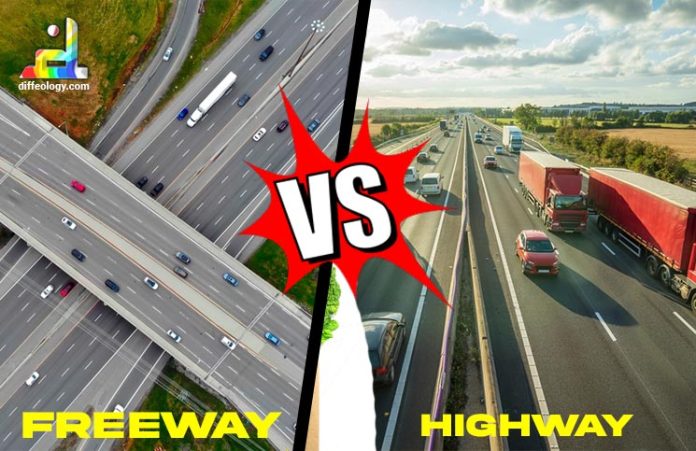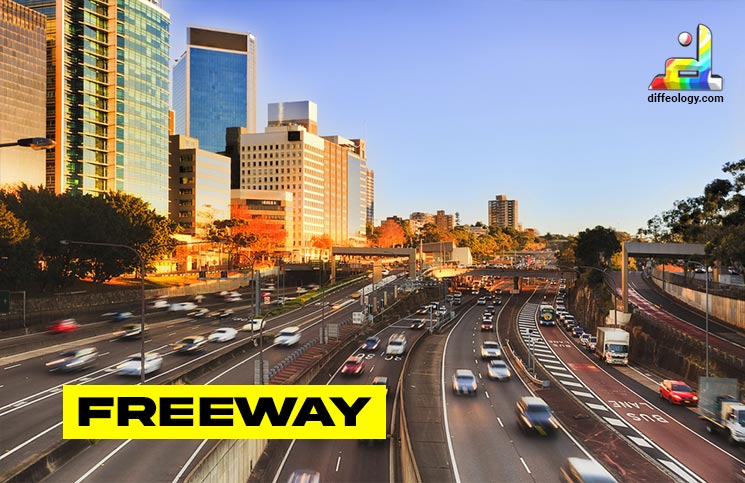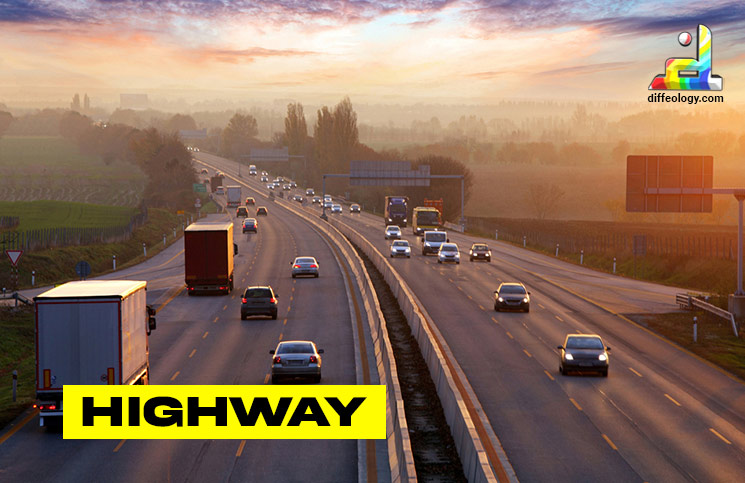When we talk about the many roads that cross our neighborhoods, two words often come up freeway and highway. Sometimes, people use these words interchangeably, but they actually mean different kinds of roads. It’s important for drivers to know these differences to travel efficiently and understand the various types of roads we use. There is a huge Difference Between freeway and highway, as they are not the same.
A big difference is how freeways control entry and exit. They have limited points where you can get on and off, making traffic flow better and the roads safer. Highways, being more general, can have different levels of control, letting them have various designs. You can see this in how freeways have special things like median barriers, while highways can look different based on where they are and what they’re for.
Freeways are a special kind of road that’s part of highways. What makes them stand out is how carefully they control who gets on and off. These fast roads are designed to keep traffic moving smoothly, using things like ramps and interchanges. Freeways have wider lanes, smart engineering, and extra safety measures, making them great for long trips and fast travel in busy city areas. On the flip side, “highway” is like a big category covering lots of different public roads. It’s not just freeways; it includes all kinds of roads, each with its own features and uses.
Main Difference Between Freeway and Highway
Freeways are designed for high-traffic volumes, with multiple lanes to accommodate a large number of vehicles. Highways may experience varying levels of traffic density, depending on their location and purpose.
Freeways often feature extensive signage and markings to guide drivers through complex interchanges and ramps. Highways may have simpler signage, especially in less complex areas, but can still provide directional information.
Freeways are commonly found in urban landscapes, navigating through cities and metropolitan areas. Highways can traverse diverse landscapes, including rural areas, connecting different geographical regions.
Freeways are designed for high-speed travel, allowing vehicles to maintain a consistent pace with limited interruptions. Highways may have varying speed limits, accommodating different travel speeds based on their design and purpose.
Freeway Vs. Highway
What is a Freeway?
A freeway is a special type of road that’s all about making your travels faster and more straightforward. Think of it like a super-fast expressway that gets you where you need to go with less hassle. What sets freeways apart is this thing called “controlled access.” That just means the places where you get on and off the road are carefully managed, usually with ramps and interchanges. This control helps keep traffic flowing smoothly so you can reach your destination without too many delays.
When you’re driving on a freeway, you’ll notice a few things that make it different. The lanes are wider, giving more room for cars to move around. The road itself is designed with fancy engineering to handle higher speeds. Safety is a big deal on freeways, so you might see barriers in the middle of the road to keep traffic separated and extra signs to help you know where you’re going. Freeways are great for longer trips and getting around busy city areas quickly because they offer a direct path with fewer stops.
Read Also: Difference Between Distance and Displacement
In simpler words, a freeway is like a special road made to get you from one place to another quickly and easily. It’s well-planned to keep traffic moving smoothly, and it has things like wider lanes and safety features to make your journey quick and safe. So, the next time you find yourself on a road built for speed with carefully managed entry and exit points, you’re probably cruising along a freeway!
What is a Highway?
A highway is a special kind of road that helps people easily get from one place to another. Unlike smaller roads, highways are big and can go for really long distances, connecting cities, towns, and even entire states. Think of “highway” as a big group that includes all sorts of roads, each with its own special features and uses.
One interesting thing about highways is that they can look different based on what they’re meant for. Some highways are like freeways with controlled entry and exit points, kind of like on-ramps and off-ramps. Others are simpler, with regular intersections and driveways for getting on and off. How a highway is built depends on where it is and how it fits into the overall road system.
Read Also: Difference Between Steel and Alloy Wheels
Highways are super important because they bring communities together and help people travel between different areas. They can go through all kinds of places, from busy cities to quiet countryside spots, making it easier for folks who live there and those going on long trips. So, whether you’re just heading to the store nearby or going on a big road adventure, chances are you’ll be using a highway to make your journey easier and more convenient.
Comparison Table “Freeway Vs. Highway”
| Definition | A controlled-access type of highway. | A general term for public roads. |
| Access Control | Controlled entry and exit points. | Varying levels of access control. |
| Design | Wider lanes, ramps, and interchanges. | Diverse designs based on road type. |
| Traffic Flow | Facilitates uninterrupted, high-speed traffic. | Traffic flow varies with road type. |
| Safety Features | Enhanced safety measures, like median barriers. | Safety measures depend on the road type. |
| Purpose | Efficient for long-distance and urban travel. | Serves various purposes and road types. |
| Funding and Ownership | Often publicly funded and owned. | Can have diverse funding and ownership. |
| Location | Commonly found in urban areas. | Traverses various landscapes and areas. |
| Environmental Impact | May face challenges like air and noise pollution. | Environmental impact varies by location. |
| Traffic Management | Incorporates advanced traffic management systems. | Traffic management varies by road type. |
| Naming Conventions | The term “freeway” is commonly used in North America. | Terminology may differ regionally. |
| Traffic Density | Designed for high-traffic volumes. | Traffic density varies by road type. |
| Signage and Markings | Extensive signage and markings for guidance. | Signage varies and is simpler in some areas. |
| Landscapes Traversed | Often found in urban landscapes. | Connects various landscapes and areas. |
| Speed of Travel | Emphasis on high-speed travel. | Varies based on road type and purpose. |
| Regional Nuances | Different regional names, e.g., “motorway” in Europe. | Terminology may differ by region. |
Difference Between Freeway and Highway in Detail
1. Definition and Terminology:
Freeways and highways are big roads we use a lot, but they mean slightly different things. A freeway is a special kind of highway. It has controlled access, which means it has ramps and interchanges to manage traffic flow. On the other hand, “highway” is a general term for any public road. Freeways are like a specific type of highway designed for smooth and fast travel, with limited entry and exit points.
In North America, we usually say “freeway,” while globally, people use “highway” more often. Sometimes, these words are used interchangeably, but it’s important to know the specific features that make each one.
2. Control of Entry and Exit:
One big difference is how you get on and off these roads. Freeways have controlled access, meaning they have on-ramps and off-ramps to control where cars enter and exit. This helps traffic flow smoothly and makes things safer by reducing conflicts. Regular highways, however, can have different levels of control. Some have controlled access, like freeways, while others have more intersections, driveways, and side roads.
The controlled access to freeways makes them great for long trips and fast driving.
3. Design and Build:
Freeways and highways also look different. Freeways usually have wider lanes, bigger shoulders, and more advanced construction. They’re built to handle high speeds and lots of traffic. They might have multiple lanes in each direction, barriers in the middle, and special signs.
Highways, being a broader category, can look different. Some highways might be like freeways, with many lanes and fancy construction. Others might be simpler, with fewer lanes and less fancy stuff. The design depends on where they are, how many cars use them, and what they’re for.
4. How Traffic Moves and Speed Limits:
Freeways are made for fast and smooth driving. They have controlled access, limited entry and exit points, and good construction, so cars can move easily. Speed limits on freeways are often higher than on regular highways because they’re designed for faster driving.
Highways, being a general term, can have different speed limits and traffic conditions. Some highways are like freeways, but others might have slower speed limits and more varied traffic.
5. Interchanges and Ramps:
The places where you switch roads are different, too. Freeways have interchanges that help cars move smoothly between different roads. On-ramps and off-ramps are designed to make merging and leaving the freeway easy.
Highways, being more general, can have all kinds of intersections and access points. Some might look like freeways, with interchanges, while others have regular intersections with traffic lights.
6. Safety Stuff:
Freeways are built with more safety features than regular highways. They might have crash barriers, wider shoulders, better signs, and good visibility. Controlled access and limited entry points make freeways safer because there are fewer chances for crashes at intersections and driveways.
Highways, being more general, can have different safety features. Some might be like freeways with lots of safety stuff, while others might not have as much.
7. Purpose and Use:
Freeways and highways are used for different things. Freeways are made for efficient long-distance travel and fast commuting. They’re built to be direct routes for drivers, minimizing stops and delays. The controlled access to freeways helps keep traffic moving smoothly without a lot of interruptions.
Highways, being a broader category, have various purposes. They can be local roads, major routes, or expressways. Highways might look and work differently based on where they are and what they’re meant for, connecting different places like rural areas, cities, and suburbs.
Freeways are a special kind of highway made for fast travel with controlled access, while highways are a general term for all kinds of roads with different designs and purposes. Knowing these differences helps us use and navigate these roads better.
8. Funding and Ownership:
Let’s talk about how freeways and highways get money and who looks after them. Freeways usually get their funds from the government, and they are owned by the public. That means the money for building and taking care of them comes from taxes that people pay. The cool part is you usually don’t have to pay extra when you use freeways directly; they’re open to everyone without tolls.
Now, highways can be a bit different. Some highways also get money from the government and are taken care of by the public. But there are others that might have tolls, which means drivers have to pay a fee to use them. And guess what? Some highways are run by private companies, and they charge tolls, too. So, how freeways and highways get their money and who looks after them can be pretty different.
9. Location and Urban Context:
Let’s chat about where you find freeways and highways. Freeways usually hang out in cities and towns, helping traffic move smoothly through busy urban areas. They might have fancy twists and turns like overpasses and underpasses to make sure they don’t mess up local traffic too much.
Now, highways can go through all kinds of places. They might stretch from cities to rural areas, connecting different parts of the country. Some highways help link towns and cities, and others even connect entire states. The way they’re built depends on the places they go through, making sure they connect urban and rural communities.
10. Surrounding Land Use and Development:
Let’s talk about the stuff built around freeways and highways. Freeways usually influence where businesses and homes are built in cities. The fast roads make it easy for people to get to places, so there might be lots of activity and businesses nearby.
Highways covering different road types can impact development in various ways. Some highways might encourage new businesses and activities along their route. Others might just connect existing places without much change. What happens around these roads depends on factors like how much traffic they get, where they connect, and how much they help different communities.
11. Environmental Impact:
Now, let’s talk about how freeways and highways affect the environment. Freeways, often found in cities, might cause problems like air and noise pollution. All the cars and structures concentrated in one area can have a not-so-great impact on the environment. People need to figure out ways to make them less harmful.
Highways with different routes can also affect the environment. In rural areas, they might pass through natural landscapes, potentially causing changes to local ecosystems. Figuring out how to build roads without hurting the environment too much is a big deal for both freeways and highways.
12. Traffic Management and Congestion:
Let’s discuss how traffic is managed on freeways and highways. Freeways, built for speedy travel, often use fancy systems to control traffic. They might have electronic signs, speed limits that change, and real-time monitoring to keep cars moving smoothly and avoid traffic jams.
Highways with various designs might have different ways to handle traffic. Some use similar advanced systems, while others might stick to more regular methods. Figuring out how to manage traffic depends on things like how many lanes there are and how the road is set up. Avoiding traffic jams is a big goal for both freeways and highways.
13. Regional Naming Conventions:
Lastly, let’s talk about what people call these roads in different places. In the United States and North America, folks often say “freeway” for high-speed, controlled-access roads. In Europe and other places, they might use the term “motorway” for roads with similar features.
Even the word “highway” can mean different things in different regions. Sometimes, it only refers to big roads, and in other places, it might include many types of roads. Knowing what to call these roads in different parts of the world helps with talking about and finding your way around. It’s all about the little cultural differences that make these transportation networks interesting!
Key Points Showing the Difference Between Freeway and Highway
- Definition and Terminology: Freeways are a subtype of highways with controlled access and ramps. “Highway” is a broader term encompassing various public roads.
- Access Control: Freeways have controlled entry and exit points, reducing disruptions. Highways can vary in access control, with some having more intersections.
- Design and Infrastructure: Freeways have wider lanes, advanced engineering, and specialized signage. Highways encompass a range of designs, from simple to more complex layouts.
- Traffic Flow and Speed Limits: Freeways allow for smoother, faster travel with higher speed limits. Highways may have diverse speed limits and traffic conditions.
- Interchanges and Ramps: Freeways feature interchanges for seamless traffic transitions. Highways may have various intersections and access points.
- Safety Features: Freeways often include crash barriers, wider shoulders, and advanced signage. Highways can have varying safety measures based on location and regulations.
- Purpose and Function: Freeways focus on efficient long-distance travel and high-speed commuting. Highways serve diverse purposes, connecting rural, urban, and suburban areas.
- Funding and Ownership: Freeways are often funded by the government and publicly owned. Highways can have varied funding structures, including tolls and private ownership.
- Location and Urban Context: Freeways are associated with urban areas, designed to ease traffic flow. Highways traverse various landscapes, connecting rural and suburban regions.
- Surrounding Land Use and Development: Freeways influence concentrated development in urban areas. Highways may stimulate or connect existing developments, depending on the region.
- Traffic Management and Congestion: Freeways incorporate advanced traffic management systems for high-speed travel. Highways may use various approaches to manage traffic, depending on design and purpose.
- Regional Naming Conventions: “Freeway” is commonly used in North America, while “motorway” is used in Europe. The term “highway” can have different meanings in various regions.
FAQs: Freeway Vs. Highway
Conclusion
To sum it up, even though freeways and highways both help us get places, they’re quite different in how they’re built, what they do, and how they control traffic. Freeways, with their controlled entry and focus on fast travel, are like specialists for quick city and between-city trips.
Highways, being a bigger group, cover all kinds of roads that connect communities in different landscapes. Knowing the Difference Between Freeway and Highway helps us make smart choices as we travel, making our journeys safer and smoother on the many roads we use every day.



